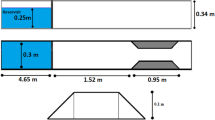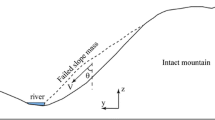Abstract
In a former study, water impoundment at a high arch dam (located in southwest China) was simulated using fluid-mechanical elasto-plastic analyses to predict deformation mechanisms taking place at the scale of the valley (Hou et al., IOP Conf Ser: Earth Environ Sci 570:022033, 2020). In this continuation work, we review the findings, clarify the mechanism of valley deformation caused by changes in impoundment level, and present the results of a sensibility study that accounts for the presence of drainage volumes at the site. With no account for drainage volumes, the model predicts valley expansion along measuring lines upstream from the dam, and valley contraction downstream. Also, valley contraction increases with measuring line elevation. Valley deformation occurs during changes of impoundment; this reflects the mechanical response to the change in dead weight of standing impoundment water. Deformation also takes place at constant impoundment level; this is caused by large-scale water seepage under and around the dam in the valley banks. A decrease in impoundment level generates a relative increase in valley contraction in the model, both upstream and downstream of the dam. This behavior is explained by the mechanical relaxation of lateral pressure that acts on the valley banks when the impoundment level is reduced. With drainage domains (associated with tunnels and powerhouse caverns) accounted for in the model, it was expected that the associated drop in fluid pressure would reduce the predicted valley contraction in the dam vicinity. Indeed, in this case, a mechanism of valley expansion is predicted to develop along all monitoring lines in the model.
Access this chapter
Tax calculation will be finalised at checkout
Purchases are for personal use only
Similar content being viewed by others
References
Liang G, Hu Y, Fan Q, Li Q (2016) Analysis on valley deformation of Xiluodu high arch dam during impoundment and its influencing factors. J Hydroelectr Eng 35(9):101–110
Zhou Z, Li M, Zhuang C, Guo Q (2018) (2018) Impact factors and forming conditions of valley deformation of Xiluodu Hydropower Station. J Hohai Univ (Natural Sciences) 46(6):497–505
Zhang G, Cheng H, Zhou Q, Liu Y (2019) Analysis of mechanism of valley creep deformation of high arch dam during impoundment. China Sci Pap 14(1):77–84
Detournay C, Cheng Z, Peterson R, Cundall PA (2020) Baihetan Dam—stress and seepage analysis final report, phase 1”, Itasca Consulting Group, Inc., Report to PowerChina Huadong Engineering Corporation Limited, 2-6179-01:20R01. Minneapolis, Minnesota
Hou J, Xu J, Meng G, Chu W, Cheng Z, Detournay C, Cundall PA (2020) Analysis of the effect of dam impoundment at the Baihetan site using coupled fluid-mechanical elasto-plastic simulations. IOP Conf Ser: Earth Environ Sci 570:022033
Meng G, Detournay C, Cundall P (2020) Formulation and application of a constitutive model for multijointed material to rock mass engineering. Int J Geomech 20(6)
Itasca Consulting Group, Inc. (2018) FLAC3D—Fast Lagrangian analysis of Continua in three dimensions, Ver. 7.0. Minneapolis: Itasca
Itasca Consulting Group, Inc. (2015) FLAC—Fast Lagrangian analysis of Continua, Ver. 8.0. Minneapolis: Itasca
Cundall P (2020) The art of numerical modeling in geomechanics. Geo-Congress 2020 GSP 321. ASCE
Acknowledgements
This work was conducted with the financial support of Mr. Hou, PowerChina Huadong Engineering Corporation Limited, Hangzhou 311122, Zhejiang, China. The help and collaboration of our friend and colleague Weijiang Chu is gratefully acknowledged. Without his enduring support, this work would not have been possible.
Author information
Authors and Affiliations
Corresponding author
Editor information
Editors and Affiliations
Rights and permissions
Copyright information
© 2022 The Author(s), under exclusive license to Springer Nature Singapore Pte Ltd.
About this paper
Cite this paper
Detournay, C. et al. (2022). Numerical Simulation of Water Impoundment at a High Arch Dam Site. In: Wahab, M.A. (eds) Proceedings of the 4th International Conference on Numerical Modelling in Engineering . NME 2021. Lecture Notes in Civil Engineering, vol 217. Springer, Singapore. https://doi.org/10.1007/978-981-16-8185-1_3
Download citation
DOI: https://doi.org/10.1007/978-981-16-8185-1_3
Published:
Publisher Name: Springer, Singapore
Print ISBN: 978-981-16-8184-4
Online ISBN: 978-981-16-8185-1
eBook Packages: EngineeringEngineering (R0)




